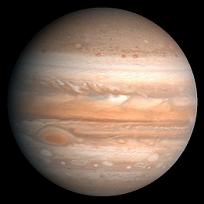How big is Jupiter?

Jupiter is the biggest planet in the solar system. It was named after the highest mythical Roman god who ruled over all the deities who live in Mt. Olympian. The name was given to the planet even before its exact mass was learned. But it was branded just right.
When it comes to size, dimension and mass, Jupiter way outranks all the other planets in the solar system. Even if all mass of the other seven planets are combined, Jupiter’s mass is still more than twice bigger and heavier. The mass or weight of Jupiter is measured to be 1.8986 x 1027 kg and is equivalent to 317.8 times the mass of Earth. Its volume or the measurement of space that it covers is 1.43128×1015 km3 or 1321.3 times that of Earth. It is 1,321.3 times wider and bigger than Earth but is less dense, that’s why it’s only 317.8 times heavier.
Its density is around 1.33 grams per cm3, which is just a little denser than water. It is equivalent to ¼ of Earth’s density. The Earth’s composition consists chiefly of metal and rock, which are both very dense. On the other hand, Jupiter is a giant ball made mainly of gas and liquid. The possibility of the existence of solid material in the planet is still unknown. Astronomers believe that it has a low density because it consists chiefly of hydrogen and helium, which are the lightest elements.
It is also believed that Jupiter’s core is made of the same heavy elements as that of the Earth’s. This has not been proven yet, but the core is thought to be rocky. The existence of it was only based on observations on Jupiter’s gravity. Outside the core is possibly a layer made of metallic hydrogen and some helium.
Jupiter’s atmosphere is made up of mostly hydrogen, some helium, and small amounts of methane, phospine, ammonia, germanium, carbon monoxide, ethane, acetylene and water. These substances have created different colored layers of clouds in varying altitudes. There are ammonia clouds, blue clouds made from different elements and water clouds. Jupiter’s size and composition is possibly the reason why it has numerous moons orbiting around it. It has 63 known moons and more may be further discovered. The global surrounding of Jupiter is just unbelievably vast that it cannot be totally encompassed by numerous flybys and spacecraft explorations that have been sent to the planet. So far, the outermost moon is known to orbit the planet at an average distance of 29.54 gigameters in 980 Jupiter days. It was discovered in March 4, 2003.
The volume, density and composition of Jupiter are believed to cause it to shrink at 2 cm per year. Its gravitational field causes the dense materials around its core to shrink and this produces heat. It’s the reason why Jupiter radiates more heat than it receives from the sun. This also means that when Jupiter was born, it could have been hotter and more massive.